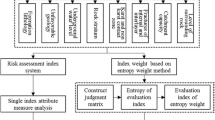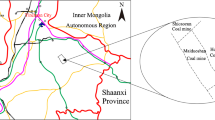To effectively control the collapse risk of unstable rock masses, an attribute recognition model for risk assessment of unstable rock mass on high-steep slopes is established using attribute mathematical theory. The lithology, geologic structural, slope gradient, slope shape, rainfall, slope, vegetation, and human activity are selected as risk assessment indices with grading criteria of each index. The weights of assessment indices are determined using a judgment matrix constructed using the analytic hierarchy process. The attribute measurement functions are used to compute attribute measurement of a single index and a synthetic attribute measurement. The identification and classification of risk assessment of the unstable rock mass are assessed using a confidence criterion. The fatalness of an actual unstable rock mass on high-steep slope is evaluated based on the previously established attribute recognition model. A method for geological disaster monitoring of the unstable rock mass in Yangjiao Town is determined based on the assessment results providing an effective approach to risk assessment of the unstable rock mass.
Similar content being viewed by others
References
R. Baker and M. Garber, "Theoretical analysis of the stability of slopes," Geotechnique, 28(4), 395-411 (1978).
L. A. Pierson, S. A. Davis, and R. Van Vickle, "Rockfall Hazard Rating System: Implementation Manual," Hazards (1990).
A. Cancelli and G. Crosta, "Hazard and risk assessment in rockfall prone areas," Risk and Reliability in Ground Engineering, Vol. 15, B. O. Skipp, ed., ASCE (1993).
A. Azzoni, G. L. Barbera, and A. Zaninetti, "Analysis and prediction of rockfalls using a mathematical model," Int. J. Rock Mech. Min. Sci., 32(7), 709-724 (1995).
G. Crosta and P. Frattini, "Rainfall thresholds for the triggering of soil slips and debris flows," Conference on Mediterranean Storms (2001).
F. Guzzetti, P. Reichenbach, and S. Ghigi, "Rockfall Hazard and Risk Assessment along a Transportation Corridor in the Nera Valley, Central Italy," Environ. Manage., 34(2), 191-208 (2004).
Q. Xu, "Risk assessment method for single rockfall geo-disaster:a case study on the rockfall in Danba County, Sichuan, China," Geol. Bull. China, 28(8), 1039-1046 (2009).
H. X. Zhang and P. Wang, "Application of fuzzy comprehensive judgment method in risk evaluation and investigation of perilous rocks," Technol. Highway Transport (2009).
J. Y. Wang, Y. C. Zhang, and Q. Wang, "Mechanism analysis and risk assessment of the dangerous rock mass in the northern slope of Changbai mountain," Geology & Resources, (2010).
S. Q. Ye and H. K. Chen, "The evaluation method for the hazard grading of the rockfall at the slope segment of the tunnel entrance," China Railway Sci., (2010).
J. Zhang, L. M. Zhang, and W. H. Tang, "Slope reliability analysis considering site-specific performance information," J. Geotech. Geoenviron. Eng., 137(3), 227-238 (2011).
W. Zhang, J. P. Chen, W. Zhang, L. Yan, Y. F. Ma, and H. Xiong, "Determination of critical slip surface of fractured rock slopes based on fracture orientation data," China-Technol. Sci., 56(5), 1248-1256 (2013).
L. L. Zhang, M. D. Fredlund, D. G. Fredlund, H. Lu, and G. W. Wilson, "The influence of the unsaturated soil zone on 2-D and 3-D slope stability analyses," Eng. Geol., 193, 374-383 (2015).
Q. S. Cheng, "Attribute mathematical model and fuzzy mathematical model for quality assesssment," Application of Statistics & Management (1997).
Q. S. Cheng, "Attribute sets and attribute synthetic assessment system," Systems Engineering − Theory & Practice (1997).
C. Q. Wen, "Classification of rock-mass stability based on attributive mathematical theory," J. Hydroelectric Eng., 27(3), 75-80 (2008).
C. P. Wen and G. L. Yang, "The seismic stability evaluation of the rock and soil slope based on the attribute mathematical theory," China Railway Science (2010).
Z. Q. Zhou, S. C. Li, L. P. Li, S. S. Shi, S. G. Song, and K. Wang, "Attribute recognition model of fatalness assessment of water inrush in karst tunnels and its application," Rock Soil Mech., 34(3), 818-826 (2013).
D. Huang, Y. X. Song, D. F. Cen, and G. Y. Fu, "Numerical modeling of earthquake-induced landslide using an improved discontinuous deformation analysis considering dynamic friction degradation of joints," Rock Mech. Rock Eng., 49(12), 4767-4786 (2016).
C. J. Ouyang, K.Q. Zhou, Q. Xu, J. H. Yin, D. L. Peng, D. P. Wang, and W. L. Li, "Dynamic analysis and numerical modeling of the 2015 catastrophic landslide of the construction waste landfill at Guangming, Shenzhen, China," Landslides, 14(2), 1-14 (2017).
Q. Li and N. Li, "Attribute interval recognition theoretical model with application," Mathematics in Practice & Theory (2002).
F. B. Zhang, Y. J. Bai, L. Y. Xie, M. Y. Yang, Z. B. Li, and X. R. Wu, "Runoff and soil loss characteristics on loess slopes covered with aeolian sand layers of different thicknesses under simulated rainfall," J. Hydrol., 549, 244-251 (2017).
H. T. Hu, Collapse and Rockfall, China Railway Publishing House, Beijing (1989).
L. Z. Wu, L. M. Zhang, Y. Zhou, Q. Xu, B. Yu, G. G. Liu, and L. Y. Bai, "Theoretical analysis and model test for rainfall-induced shallow landslides in the red-bed area of Sichuan," Bull. Eng. Geol. Environ., 77(4), 1343-1353 (2017).
L. Z. Wu, Y. Zhou, P. Sun, J. S. Shi, G. G. Liu, and L. Y. Bai, "Laboratory characterization of rainfall-induced loess slope failure," Catena, 150, 1-8 (2017).
J. Qian, L. Zhang, W. Wang, and Q. Liu, "Effects of vegetation cover and slope length on nitrogen and phosphorus loss from a sloping land under simulated rainfall," Pol. J. Environ. Stud., 23(3), 835-843 (2014).
Y. Li, C. Hou, Q. Wang, Y. Chen, J. Ma, and Z. Mohammad, "Effect of no-till farming and straw mulch on spatial variability of soil respiration in sloping cropland," Pol. J. Environ. Stud., 25(6), 2499-2508 (2016).
M. Marschalko, I. Yilmaz, M. Bednarik, and K. Kubecka, "Influence of underground mining activities on the slope deformation genesis: Doubrava Vrchovec, Doubrava Ujala and Staric case studies from Czech Republic," Eng. Geol., 147-148(15), 37-51 (2012).
T. L. Saaty, "How to make a decision: The analytic hierarchy process," Eur. J. Oper. Res., 24(6), 19-43 (1994).
Author information
Authors and Affiliations
Corresponding author
Additional information
Translated from Osnovaniya, Fundamenty i Mekhanika Gruntov, No. 2, p. 31, March-April, 2021.
Rights and permissions
About this article
Cite this article
Tao, Y., Xue, Y., Zhang, Q. et al. Risk Assessment of Unstable Rock Masses on High-Steep Slopes: An Attribute Recognition Model. Soil Mech Found Eng 58, 175–182 (2021). https://doi.org/10.1007/s11204-021-09724-0
Published:
Issue Date:
DOI: https://doi.org/10.1007/s11204-021-09724-0




